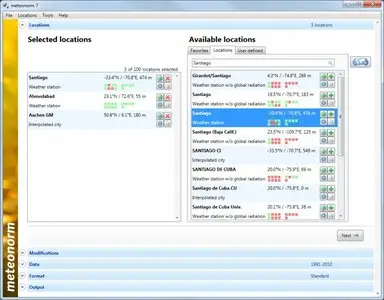Meteonorm 7.1.3.19872 | 237.8 Mb
Meteonorm is a comprehensive meteorological reference. It gives you access to a catalogue of meteorological data for solar applications and system design at any desired location in the world. It is based on more than 25 years of experience in the development of meteorological databases for energy applications. Meteonorm addresses engineers, architects, teachers, planners and anyone interested in solar energy and climatology.
Why do I need Meteonorm?
Meteonorm is considered to be the meteorological reference for the following applications: solar energy, building design, heating & cooling systems, education, renewable energy system design, agriculture and forestry, environmental research and many more!
8'325 meteorological stations worldwide
Numerous global and regional databases have been combined and checked for their reliability. In the present version, most of the data is taken from the GEBA (Global Energy Balance Archive), from the World Meteorological Organization (WMO/OMM) Climatological Normals 1961–1990 and from the Swiss database compiled by MeteoSwiss.
The periods 1961–1990 and 2000–2009 are available for temperature, humidity, wind speed and precipitation; the periods 1981–1990 and 1991–2010 for solar radiation.
Monthly climatological (long term) means are available for the following eight parameters:
global radiation
ambient air temperature
humidity
precipitation
days with precipitation
wind speed
wind direction
sunshine duration
The station data is supplemented by surface data from five geostationary satellites. This data is available on a global grid with a horizontal resolution of 8 km (3 km in Europe and Northern Africa).
Interpolation – data for any site worldwide
Usually, measurement data can only be used in the vicinity of a weather station. Elsewhere, the data has to be interpolated between different stations. The sophisticated interpolation models inside Meteonorm allow a reliable calculation of solar radiation, temperature and additional parameters at any site in the world. The intuitive GUI in Meteonorm 7 allows you to easily manage and select your weather stations and sites.
Import current as well as your own data
Meteonorm offers dynamic web downloads of current monthly temperature and radiation data (for Europe available data from 2007 onwards). With one mouse click, current data is imported from the internet and displayed. This allows solar energy calculations and performance checks of energy systems based on current data sets.
You can import your own monthly or hourly radiation and temperature data into Meteonorm with a specific import interface. Subsequently, you can apply the Meteonorm models and procedures to this data to gene rate random time series.
Calculation of hourly and minute values
From the monthly values (station data, interpolated data or imported data), Meteonorm calculates hourly values of all parameters using a stochastic model. The resulting time series correspond to “typical years” used for system design.
Additionally, the following parameters are derived:
solar azimuth and elevation
global, diffuse and beam (direct normal) radiation as well as radiation on inclined planes
longwave radiation
luminance
UVA/UVB, erythemal radiation
precipitation, driving rain
humidity parameters (dewpoint, relative humidity, mixing ratio, psychrometric temperature)
The generation of humidity values is optimized to fit building and climate system simulations (including extreme hourly values).
Additionally a stochastic generation model for minute values of radiation parameters is available.
Effects of high horizon considered
Meteonorm calculates reduced global radiation caused by a high horizon. The horizon line can easily be entered either graphically (drag line) or numerically. For most regions of the world, the horizon line is calculated automatically, based on a digital terrain mode (accessed over the internet).
Any rectified picture of the horizon can be imported and used as a background for digitizing the horizon. As a new feature in Meteonorm 7, images taken with the Horicatcher can be imported and processed directly inside Meteonorm. The additional Horicatcher software is not needed anymore.
The horizon pictures can be use to determine easily the areas where glare effects exist.
Horicatcher
The Horicatcher is an add-on for Meteonorm. It is an accurate and fast tool to determine the real horizon line at your specific site. Horicatcher allows you to take into account the reduced solar energy input, the sunshine duration and sun exposure by obstacles like trees, houses or mountains at your site.
Data export
36 different predefined export formats are available. They cover most of the established simulation software in solar energy applications and building design, including TMY2 and TMY3, EPW, TRNSYS as well as output formats for TRY (German test reference years), POLYSUN, TSOL/PVSOL, PVSyst and PHPP. All export formats are available for hourly as well as monthly values. Data is written to ASCII files.
Alternatively, the parameters and the desired units can be defined in a user-defined export format.
Access
Irradiation and other weather data for any location on Earth.
Global Data
The database is fed by 8'325 weather stations worldwide as well as by five geostationary satellites with global coverage.
Highest Precision
Built-in state of the art interpolation models deliver data for any location worldwide with a precision compareable to measurements.
Historical Data
The standard is 1991–2010 for irradiation and 2000–2009 for other parameters; other periods can be selected.
Current Data
Current data can be accessed online directly from the software. User data can also be imported.
Future Data
Meteonorm contains several climate change scenarios, so you can also plan for the future.
Over 30 Parameters
Global radiation, direct radiation, temperature, precipitation, humidity, wind etc. See the list of all parameters.
Time Intervalls
Meteonorm delivers monthly, hourly and even minute values.
Export Formats
More than 35 output formats are available: CSV, TMY2, TMY3, EPW, PVSol, PVSyst, Polysun etc. See the list of all formats.
Home Page - http://meteonorm.com/en/





